|
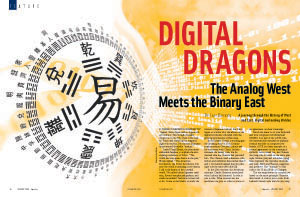 IS THERE SOMETHING INHERENTLY "digital" about Japan and its hypermodern culture? This thought initially struck me in the 80s, when I first visited Tokyo and soaked up its magnetic high-tech tension. By contrast, European cities seemed decidedly "analog." IS THERE SOMETHING INHERENTLY "digital" about Japan and its hypermodern culture? This thought initially struck me in the 80s, when I first visited Tokyo and soaked up its magnetic high-tech tension. By contrast, European cities seemed decidedly "analog."
I asked Kenji Ekuan, the prominent industrial designer, to explain the electrifying modernity of Tokyo. "The world has seen great drama in the past," Ekuan replied. "The American Revolution, the Soviet Revolution. But now the world is awaiting a new drama. I call it the drama of the material world." He talked about Japanese tradition, Kyoto's temples and gardens, and made me realize I had some homework to do. I went to the library to study the sources of Japanese culture. But I also began to wonder why the advent of the digital revolution coincided with the growing prominence of East Asia.
In the library I found a smoking gun: the amazing story of 17th Century mathematician Gottfried Leibniz and his encounter with China. Leibniz invented the binary code, but he claimed that the Chinese had preceded him. The Chinese used a different code, broken and unbroken lines rather than 0 and 1, but Leibniz argued that the principle was the same (see table III).
In the 20th century, the American scientist Claude Shannon articulated what Leibniz had intuited: A code is just a code. What matters are the attributes we give to codes to come to an agreement on their meanings.
Punch the letter A on your keyboard and your computer will think/read 0100001. It is part of the ASCII code, the international standard for alphanumerical symbols on computer keyboards. ASCII is a basic example of a mutual agreement on the meaning of symbols. As it turned out, the Chinese yin-yang code is based on the same principle: Broken (yin) and unbroken (yang) lines represent the opposites of female and male, Earth and Heaven, negatives and positives. The "manual" to this code is the Yi-jing (Book of Changes).
The yin-yang system is complex yet based on the same principle Shannon discovered: A code is just a code. Both Leibniz's binary code and the yin-yang code are based on two symbols. But what is the distinction between analog and digital phenomena? Scientists first tackled this question in the 40s, when digital (more properly, binary) computers replaced analog machines. Nicholas Negroponte popularized the issue in 1996 with his book Being Digital, in which he outlined the nature of the digital revolution and the impact it has had on our lives.
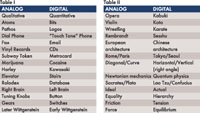 His book triggered a response from Carol Wilder, who questioned the notion of being digital. Her paper, teasingly called "Being Analog" (1998), argued that the human experience of reality remains very much an analog affair. Wilder points out that Negroponte had in fact come to the same conclusion: "The world, as we experience it, is a very analog place. From a macroscopic point of view, it is not digital at all but continuous. Nothing goes suddenly on or off, turns from black to white, or changes from one state to another without going through a transition." His book triggered a response from Carol Wilder, who questioned the notion of being digital. Her paper, teasingly called "Being Analog" (1998), argued that the human experience of reality remains very much an analog affair. Wilder points out that Negroponte had in fact come to the same conclusion: "The world, as we experience it, is a very analog place. From a macroscopic point of view, it is not digital at all but continuous. Nothing goes suddenly on or off, turns from black to white, or changes from one state to another without going through a transition."
In her paper, Wilder shows how the analog-digital issue operates on different levels and has many dimensions. She classified a number of things and phenomena as analog and digital (table I is a partial list). This exercise, albeit subjective, is useful in understanding the heart of the issue.
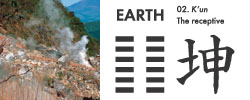 I cannot vouch for the digital quality of cocaine, but most of Wilder's list feels right. If you study the cultural traits of Europe and East Asia, you might conclude that an analog sensibility governed the development of European culture and a digital (more properly binary) sensibility guided the development of East Asian culture. I cannot vouch for the digital quality of cocaine, but most of Wilder's list feels right. If you study the cultural traits of Europe and East Asia, you might conclude that an analog sensibility governed the development of European culture and a digital (more properly binary) sensibility guided the development of East Asian culture.
Consider the contrasts in table II.
Anyone familiar with East Asian culture can appreciate at least some of these contrasts as they reflect the development of the binary code in the West and the role of the yin-yang principle in the development of East Asian (Confucian) culture.
Japan retained more of its animistic roots than China. But in the 7th century, the wholesale importation of China's cultural complex (architecture, arts, Confucianism) transformed Japan from a tribal society into a highly structured civilization.
 God and nothing God and nothing
The invention of the binary code was part of Leibniz's attempt to construct a mechanical calculator. He realized that using only two numbers would simplify the construction of such a device and would require fewer parts. Our common decimal system is based on 10 digits. Higher numbers, 10 and above, are based on the power of 10 (10, 100, 1000). Leibniz substituted the 10 digits of the decimal system with 0 and 1 and replaced the power of 10 with the power of two. Thus the binary number 1010 represented (from right to left) 0 + 2 + 0 + 8 = decimal 10; the binary number 1111 represented 1 + 2 + 4 + 8 = decimal 15.
Leibniz, a creature of his times, attached theological significance to his invention. He exclaimed: "All combinations arise from unity and nothing, which is like saying that God made everything from nothing, and that there were only two first principles -- God and nothing."
Leibniz was not only a mathematician and philosopher, he was also among the first Europeans to study Chinese civilization. He corresponded with several Europeans in China, among them the Jesuit missionary Joachim Bouvet. Leibniz sent Bouvet a paper explaining the binary code, thinking it might help the Jesuit father with his work (missionaries commonly used European science as a tool to convert the Chinese). Father Bouvet responded by sending Leibniz a diagram of the Yi-jing's 64 hexagrams, telling Leibniz that the Chinese had used a binary code for centuries.
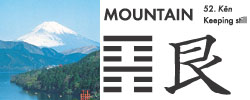 Leibniz was elated. He outlined his discovery in a paper, "Explication de l' arithmetique binaire": "What is astounding in this [binary] reckoning is that this arithmetic by 0 and 1 happens to contain the secret of the lines of an ancient Chinese king and philosopher named Fohy (Fu Xi), who is believed to have lived more than 4,000 years ago, and whom the Chinese regard as the founder of their empire and their sciences ... " Leibniz was elated. He outlined his discovery in a paper, "Explication de l' arithmetique binaire": "What is astounding in this [binary] reckoning is that this arithmetic by 0 and 1 happens to contain the secret of the lines of an ancient Chinese king and philosopher named Fohy (Fu Xi), who is believed to have lived more than 4,000 years ago, and whom the Chinese regard as the founder of their empire and their sciences ... "
Leibniz was unable to get funding for his "digital" mechanical calculator, and his binary code was forgotten until the 20th century. The early computers were analog machines. But in the 1930s, with advances in technology, scientists concluded that the binary system had distinct advantages over analog machines. Electrical pulses could be coded with binary numbers. Low current would be 0, high current 1. Binary systems only had to deal with two states: high current and low current, 0 and 1, on and off. This made them more stable than analog machines, and less susceptible to variations in electrical current.
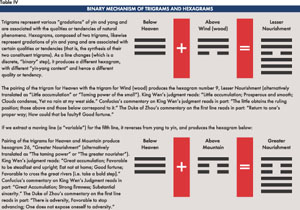 Boolean classes Boolean classes
While computer scientists recognized the utility of the binary code, they still regarded it as essentially a mathematical tool. But in 1937, Claude Shannon published a landmark thesis ("A Symbolic Analysis of Relay and Switching Circuits"), and gave the binary code a new dimension.
Shannon made two important points. First, he recognized that Leibniz's binary code dovetailed perfectly with Boolean algebra. The latter, invented in the 19th century by mathematician George Boole, had changed the nature of mathematics, but its usefulness was only fully recognized with the advent of the modern computer.
Boolean algebra enabled mathematicians to perform mathematical functions on groups or "classes" of objects. One of his biographers explained Boolean algebra with a simple example: If the symbol x represents the class of all "white objects" and the symbol y the class of all "round objects," the symbol xy represents the class of objects that are simultaneously white and round.
To perform algebraic operations on these symbols, Boole invented three operators: AND, OR and NO. This enabled mathematicians to add certain classes to others while excluding other classes. (A textbook example of a Boolean query is "hotdog AND mayonnaise OR ketchup NO salt.") Importantly, Boolean algebra enabled mathematicians to perform algebraic operations on symbols that represented units traditionally not regarded as mathematical objects. We use Boolean algebra every time we search the Internet. Without Boole and Shannon, there would have been no Google.
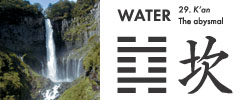 Shannon showed that Leibniz's binary code was perfectly suited for the implementation of Boolean logic in electrical circuits. The binary number 1 would denote "true" (yes, inside a class), 0 would be "false" (no, outside a class). Shannon was primarily concerned with solving mathematical problems to deal with increasingly complex telephone switching circuits that could replace human operators, but his paper provided the basis on which nearly all modern computers are built. Shannon showed that Leibniz's binary code was perfectly suited for the implementation of Boolean logic in electrical circuits. The binary number 1 would denote "true" (yes, inside a class), 0 would be "false" (no, outside a class). Shannon was primarily concerned with solving mathematical problems to deal with increasingly complex telephone switching circuits that could replace human operators, but his paper provided the basis on which nearly all modern computers are built.
The second point Shannon made was equally important. He realized that binary numbers could represent words, sounds, images and even abstract thought and ideas. This realization set the stage for the digital revolution. In 1961, John Kelly at Bell Labs programmed a computer to sing a song. (The menacing computer Hal in 2001: A Space Odyssey sang that song when its memory was unplugged.) Today, binary numbers represent everything from sounds and images (multimedia) to abstract thoughts and ideas used in artificial intelligence.
 With Shannon's thesis, the Leibniz story came full circle, illustrating that the German philosopher was years ahead of his time, both technically and philosophically. Intuition told him that the Chinese yin-yang code was universal symbolism that represented more than mere numbers. With Shannon's thesis, the Leibniz story came full circle, illustrating that the German philosopher was years ahead of his time, both technically and philosophically. Intuition told him that the Chinese yin-yang code was universal symbolism that represented more than mere numbers.
Binary generic types
The principle of yin and yang is the building block of the Yi-jing. The yin and yang system is at the heart of nearly all aspects of Chinese civilization. The yin and yang are symbols of Nature's two-fold structure: Earth and Heaven (the sun), female and male, winter and summer, dark and light, space and time. In other words, the yin and yang are generic types. Fu Xi, the legendary king philosopher mentioned by Leibniz, is credited with the creation of the Eight Trigrams, combinations of yin and yang lines that are at the heart of the Chinese view of creation -- pure yin (Earth), pure yang (Heaven) and their natural offspring, the terrestrial environment (see table III).
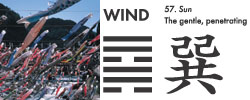 The Chinese sages paired the Eight Trigrams in all possible combinations to form the 64 hexagrams, the six-lined symbols that form the basis of the Yi-jing. This produced 64 new classes or categories. While very complex, we can think of them as Boolean classes, groups that share certain qualities. The Chinese sages paired the Eight Trigrams in all possible combinations to form the 64 hexagrams, the six-lined symbols that form the basis of the Yi-jing. This produced 64 new classes or categories. While very complex, we can think of them as Boolean classes, groups that share certain qualities.
Importantly, the qualities or tendencies associated with the Eight Trigrams carried over to the 64 hexagrams. For example, the trigram for wind (also associated with wood) placed on top of the trigram for mountain produced the hexagram "Gradual Advance." When we think of the effect of wind on a mountain (or the growth of wood), the attribute makes sense. The same can be said about the combination of the trigrams for lake and mountain. It produced the hexagram "Mutual Influence." The other hexagrams convey similar qualities and tendencies, each the "product" of its two constituent trigrams. These attributes play a key role when the Yi-jing is approached as an oracle (see table IV).
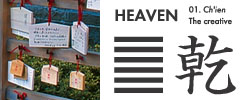 Enter Confucius Enter Confucius
The yin-yang system also was the guiding principle in the development of China's social structure. Confucius, presumed author of the commentaries on the 64 hexagrams in the Yi-jing, linked the Eight Trigrams with the family unit -- father, mother and six children. Father was yang, mother yin, and their children mixtures of the two. They share the qualities with their natural counterparts shown in table V.
The Confucian social structure is hierarchical, but "situational" rather than static. A man is yang, a woman is yin, but a man is yin to his father and yang to his son. A woman employer is yang, and her male employee is yin, because leading is yang, following is yin, just like the sun "leads" the earth. The social system duplicates the universe, and if not always logical, has an undeniable consistency. Most important of all, nature preceded humanity. The latter should adhere to the "way" of the former, lest it throw a wrench in the gears of nature's universal machinery (Tao, the "source" of yin and yang).
The Yi-jing is essentially a "manual," or guide to the bipolar universe. Consulting the book can shed light on how we fit into the larger scheme of things. We may have doubts about the wisdom of starting a new venture, getting married or moving to a new location. The Yi-jing's hexagrams confront us with a constellation of archetypal opposites -- favorable/unfavorable, gain/loss, advancing/retreating and so on. Using a "binary" logic of yes and no, pro and con, it tries to determine our place in the larger scheme of things. Marysol Sterling Gonzalez, who studied the Yi-jing in the context of transpersonal psychology, aptly referred to the book as a "psychological computer."
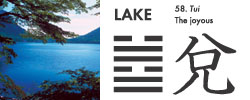 The yin-yang system operates on many levels, but there is a shortcut to grasping an essential feature in its inner workings. It is summed up with the word qi, the "tension" between yin and yang. Qi, represented by the most famous of all Chinese symbols, the dragon, transcends the physical and metaphysical. A cosmic manifestation of qi is the gravitational pull between the Sun and the Earth. In the human realm, it is the sexual tension between male and female. The Japanese word for qi is ki. It is part of words like genki (energetic) and denki (electricity). The Ryoan-ji, the famous stone garden in Kyoto, can be seen as a temple of ki. To see the "magnetic" effect of the Ryoan-ji without its aesthetic component, float a small piece of metal between two magnets, and it will settle where the tension (ki) between the two poles is most acute (see table VI). The yin-yang system operates on many levels, but there is a shortcut to grasping an essential feature in its inner workings. It is summed up with the word qi, the "tension" between yin and yang. Qi, represented by the most famous of all Chinese symbols, the dragon, transcends the physical and metaphysical. A cosmic manifestation of qi is the gravitational pull between the Sun and the Earth. In the human realm, it is the sexual tension between male and female. The Japanese word for qi is ki. It is part of words like genki (energetic) and denki (electricity). The Ryoan-ji, the famous stone garden in Kyoto, can be seen as a temple of ki. To see the "magnetic" effect of the Ryoan-ji without its aesthetic component, float a small piece of metal between two magnets, and it will settle where the tension (ki) between the two poles is most acute (see table VI).
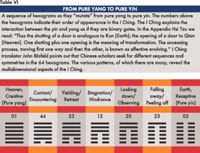 The story of Leibniz and his encounter with China illustrates that the digital revolution is not confined to information technology and digital media. It has technological, philosophical and cultural implications. Reconciling opposites, in the broad sense of the word, seems to be a theme of our time. The yin-yang system serves well to identify the issues (see table VII). The story of Leibniz and his encounter with China illustrates that the digital revolution is not confined to information technology and digital media. It has technological, philosophical and cultural implications. Reconciling opposites, in the broad sense of the word, seems to be a theme of our time. The yin-yang system serves well to identify the issues (see table VII).
If reconciling opposites is the theme of our time, the notion of qi could be the password to the 21st century. Be that as it may, it will be clear that the analog-digital issue covers a broad area. It can be discussed in terms of technology, philosophy and aesthetics. The latter is probably the most instructive. Consider the following.
An analogy is "a comparison of things based upon observations of a similarity between them." Analogy was the operative notion in Greek aesthetics. Greek artists worked "analog to nature." Their (optical) painting was analogous to visual perception, a duplication of what the eye perceived. The painting suggested a view -- frozen in time -- through an open window. Linear perspective, developed in 16th century Italy, was a direct expression of the approach to art.
 Chinese artists, by contrast, did not paint optical facsimiles of Nature's external appearance. Their monochrome paintings, composed with singular calligraphic strokes, conveyed Nature's inner (yin-yang) mechanism. The aim was to capture qi, hence China's artists were concerned with opposites (contrasts) rather than with analogies. They "digitized" sensory, analog perceptions by juxtaposing opposites -- black and white, thin ink and thick ink, convex and concave, high and low, far and near. The supreme example of this "binary" art is the classic hand scroll painting, not a "frozen" view but a pictorial synthesis of space (yin) and time (yang). Chinese artists, by contrast, did not paint optical facsimiles of Nature's external appearance. Their monochrome paintings, composed with singular calligraphic strokes, conveyed Nature's inner (yin-yang) mechanism. The aim was to capture qi, hence China's artists were concerned with opposites (contrasts) rather than with analogies. They "digitized" sensory, analog perceptions by juxtaposing opposites -- black and white, thin ink and thick ink, convex and concave, high and low, far and near. The supreme example of this "binary" art is the classic hand scroll painting, not a "frozen" view but a pictorial synthesis of space (yin) and time (yang).
A similar comparison can be made with other art forms. Europe's anthropomorphic architecture was based on analogies of the human form; East Asia's denaturalized architecture relied on modular building materials. European gardening relied on geometry; East Asian gardening juxtaposed form and space. European music was based on sound; East Asian music was based on silence or rather the interruption of silence -- a fact apparent to anyone who has watched a Kabuki performance.
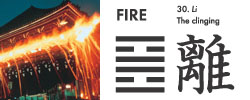 The binary nature of East Asia's cultural traditions helps explain Japan's emergence as a trendsetter in the digital age. Its artistic traditions have proven a perfect match with digital technology. Up to the 70s, Japan's industry largely followed Western trends, but in the 80s, when the digital revolution gathered steam, Japanese aesthetics flowered. Japan's designers, graphic artists and architects, inspired by their own artistic traditions, have set global trends. Its industrial designers have taken the "machine" out of the machine. Japan has lost some of its luster in the past 10 years, but the country is gearing up for the next phase of the digital revolution -- robotics. The binary nature of East Asia's cultural traditions helps explain Japan's emergence as a trendsetter in the digital age. Its artistic traditions have proven a perfect match with digital technology. Up to the 70s, Japan's industry largely followed Western trends, but in the 80s, when the digital revolution gathered steam, Japanese aesthetics flowered. Japan's designers, graphic artists and architects, inspired by their own artistic traditions, have set global trends. Its industrial designers have taken the "machine" out of the machine. Japan has lost some of its luster in the past 10 years, but the country is gearing up for the next phase of the digital revolution -- robotics.
In the years to come, robots will replace PCs, consumer electronics and perhaps even cars, as the mainstay of the economy. Japan is well-equipped to lead the world into the robotic age. Creating humanoid robots with digital brains -- and putting human-like emotions in the machine -- is an art reconciling opposites: human and machine, spirit and matter, and aesthetics and ethics.
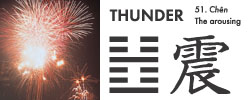 The issue of aesthetics and ethics came up when I talked to Kenji Ekuan in Tokyo. I asked him how he came to be an industrial designer. He said he grew up in Hiroshima and expected to succeed his father as head of a local Buddhist temple. But the war interfered. "When I returned to the city after the war, I got a big shock," he explained. "Street cars were laying upside down like helpless turtles, trees were blackened and bare, buildings completely destroyed. It was an ugly sight. So instead of taking over my father's temple, I decided to devote my life to creating beauty." The issue of aesthetics and ethics came up when I talked to Kenji Ekuan in Tokyo. I asked him how he came to be an industrial designer. He said he grew up in Hiroshima and expected to succeed his father as head of a local Buddhist temple. But the war interfered. "When I returned to the city after the war, I got a big shock," he explained. "Street cars were laying upside down like helpless turtles, trees were blackened and bare, buildings completely destroyed. It was an ugly sight. So instead of taking over my father's temple, I decided to devote my life to creating beauty."
Later I learned that Ekuan's aesthetic (rather than moral) response to the destruction he witnessed derives from an ancient East Asian notion, one that equates ethics with aesthetics: If something is beautiful, it cannot be bad. @
|